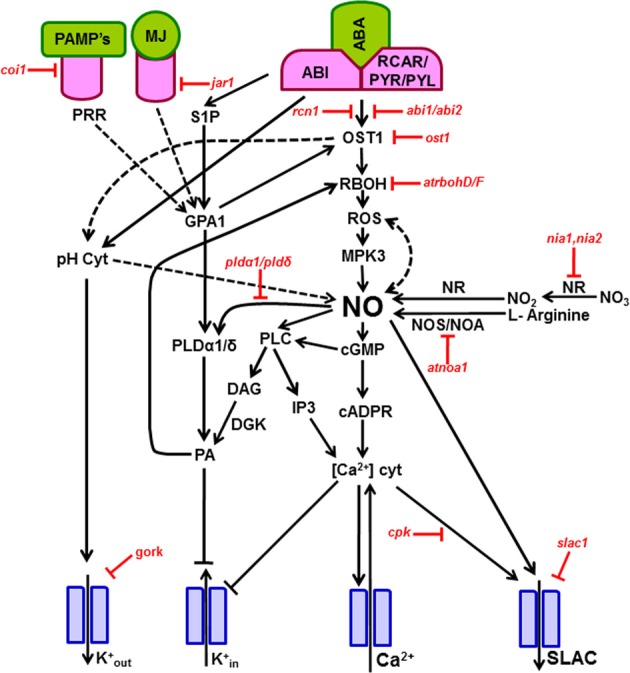Figure 1.

Signal transduction mechanism involved during stomatal closure induced by ABA, MJ, and microbial elicitors. The components/secondary messengers induced by either ABA or MJ or elicitors leading to the production of nitric oxide are indicated by forward arrows. The ion channels are represented by blue color. During stomatal signaling mechanism the guard cells upon perception of ABA, MJ, or elicitors, activate NADPH oxidase, leading to a burst of ROS, which leads to a NO burst. The elevation of NO raises the cytosolic free Ca2+, through up-regulation of cADPR and cGMP. In turn, the high cytosolic Ca2+ causes a down-regulation of K+ inward channels and activation of outward anion channels, all leading to stomatal closure. Parallely, NO can increase the levels of PA via modulation of PLD and PLC. Several of these steps are validated by the use of mutants of Arabidopsis (indicated by red color), deficient in a particular signaling component. In the mutants, the relevant steps are blocked. The Arabidopsis mutants represented in this Figure are: abi1/abi2, ABA-insensitive (ABI1 and ABI2 protein phosphatases); atrbohD/F, A. thaliana NADPH oxidase catalytic subunit D/F; atnoa, A. thaliana nitric oxide-associated 1; coi1, coronatine-insensitive 1 mutant; cpk, calcium-dependent protein kinase; gork, guard cell outward rectifying K+ channel; jar1, JA response 1 mutant; nia1, nia2, Nitrate reductase double mutant; ost1, open stomata 1 kinase; pldα1/pldδ, phospholipase α1/phospholipase δ double mutant; rcn1, protein phosphatase 2A regulatory A subunit 1; slac1, slow anion channel-associated 1 mutant. A description of these components is given in the section on “Signaling components in guard cells during NO action.” Further information can be seen in Tables 1, 2. Abbreviations are listed in first page. The events demonstrated by experimental evidence are represented by solid arrows. The possible interactions/effects are indicated by broken arrows.
